| Industry | Automotive industry |
|---|---|
| Founded | 1923 |
| Headquarters | Italy |
Area served | Worldwide |


Weber Carburetors is an automotive manufacturing company founded in 1923, known for their carburetors.
| Industry | Automotive industry |
|---|---|
| Founded | 1923 |
| Headquarters | Italy |
Area served | Worldwide |


Weber Carburetors is an automotive manufacturing company founded in 1923, known for their carburetors.
Eduardo Weber began his automotive career working for Fiat, first at their Turin plant (in 1914) and later at a dealership in Bologna. After WWI, with gasoline prices high, he reached a certain success in selling conversion kits for running trucks on kerosene instead. [1] The company was established as Fabbrica Italiana Carburatori Weber in 1923 when Weber produced carburetors as part of a conversion kit for Fiats. Weber pioneered the use of two-stage twin-barrel carburetors, with two venturis of different sizes (the smaller one for low-speed/rpm running and the larger one optimised for high-speed/rpm use).
In the 1930s, Weber began producing twin-barrel carburetors for motor racing, where two barrels of the same size were used. These were arranged so that each cylinder of the engine had its own carburetor barrel. These carburetors found use in Maserati and Alfa Romeo racing cars. Twin updraft Weber carburetors fed superchargers on the 1938 Alfa Romeo 8C competition vehicles. [2]
Fiat assumed control of the company in 1952 following Weber's disappearance in 1945. In time, Weber carburetors were fitted to standard production cars and factory racing applications from automotive marques such as Abarth, Alfa Romeo, Aston Martin, BMW, Chrysler, Ferrari, Fiat, Ford, IKA, Lamborghini, Lancia, Lotus, Maserati, Morgan, Porsche, Renault, Triumph and Volkswagen.
In 1986, Fiat also took control of Weber competitor Solex, and merged the two into a single company (Raggruppamento Controllo Motore, or the "Engine Management Group"). This was then reorganized as Magneti Marelli Powertrain S.p.A. in 1986. [3] Genuine Weber carburetors were produced in Bologna, Italy, up until 1992, when production was transferred to Madrid, Spain, where they continue to be made today. [1] Weber carburetors are made in a facility owned by LCN Automotive [4] based in Spain. There are only two direct distributors of Spanish Weber carburetors: Webcon [5] based in the UK, and WorldPac (known as RedlineWeber) [6] in the US. Webcon operates a global distribution chain via a long established network of dealers and specialists, many of whom are located in the EU.
In modern times, fuel injection has replaced carburetors in both production cars and most modern motor racing, although Weber carburetors are still used extensively in classic and historic racing. They are also supplied as high-quality replacements for problematic OEM carburetors. Weber fuel system components are distributed by Magneti Marelli, Webcon UK Ltd., and, in North America, by several organizations, including Worldpac, marketing under the Redline name. Other suppliers include Overseas Distributing, Pierce Manifolds & Lynx Weber in Australia.[ citation needed ]
Weber carburetors are sold for both street and off-road use, with the twin-choke sidedraft DCOE (Doppio Corpo Orizzontale E; "Double-Body Horizontal E") being the most common one. They are sold in what is referred to as a Weber conversion kit. A Weber conversion kit is a complete upgrade package consisting of a Weber carburetor, intake manifold or manifold adapter, throttle linkage, air filter, and all of the hardware needed for installation on a vehicle.
Weber carburetors are marked with a model code on the mounting flange, the body, or on the cover of the float chamber. [7] This begins with a number which originally indicated the diameter (in millimetres) of the throttle bore, but later lost this significance. If this number has a single pair of digits, both chokes are of the same diameter and operate together; if it has two pairs of digits separated by a stroke (e.g. 28/36), there are primary and secondary chokes that are opened one after the other, usually of differing diameter. [8]
These numbers are followed by a group of letters, which indicate various features: the DCOE is a sidedraft unit, all others being downdraft; the DCD has a piston-type starter valve as opposed to a strangler choke; and so on. [9] After the letters there will be a further number, which may be followed by a letter, e.g. 4B, 13A; these indicate the series, which in turn almost always indicates the original equipment fitment of the product. [10] The full designation might be 40 DCOE 29, 45 DCOE 9, etc. [11]
Copies of DCOE, IDF, IDA or DGV carburetors can be found made by other companies, like EMPI, FAJS or REEDMORAL, LOREADA, often at up to half the price of the authentic Spanish Weber versions[ citation needed ]. Often these are referred to as Knock offs, Clones or 'fakes' [12] by Weber users. Most of these copies are manufactured in China, and being direct copies means that parts are at least meant to be interchangeable. Operation however, usually varies from the original, due to inaccurate drilling and poorly calibrated parts and use of different quality materials. If there is a problem arising from a poorly prepared carb, it is often most noticeable during idle or cruise. Interchangeability works in both directions, as internal parts may also be swapped for original ones. [13] Webcon has some handy downloads to help tell genuine Webers from fake Fake Weber 1 Fake Weber 2
Proper carburetor jetting is based on engine displacement, RPM and engine usage. Either one or more carburetors connected to each other are used. For small engines, even only one half of the carburetor was used, with the other half blinded and partially cut off. The basic carburetor size can be selected by the butterfly valves, for DCO/DCOE the sizes are 38/40/42/45/48/50/55, with 40/45/48/50/55 being more common and available today. Jet size is based on choke size, and choke size is just based on engine displacement, RPM and application. Today you can simplify the calculation work and use an online jetting calculator [14] or go through the jetting tables and match your case. [15]

Alfa Romeo Automobiles S.p.A. is an Italian luxury carmaker known for its sports-oriented vehicles, strong auto racing heritage, and iconic design. Headquartered in Turin, Italy, it is a subsidiary of Stellantis Europe and one of 14 brands of multinational automotive company Stellantis.

A carburetor is a device used by a gasoline internal combustion engine to control and mix air and fuel entering the engine. The primary method of adding fuel to the intake air is through the Venturi tube in the main metering circuit, though various other components are also used to provide extra fuel or air in specific circumstances.
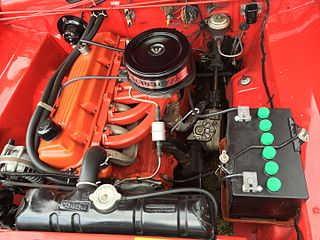
The Slant-Six is the popular name for a Chrysler inline-6 internal combustion engine with an overhead valve reverse-flow cylinder head and cylinder bank inclined at a 30-degree angle from vertical. Introduced in 1959 for the 1960 models, it was known within Chrysler as the G-engine. It was a clean-sheet design that began production in 1959 at 170 cubic inches (2.8 L) and ended in 2000 at 225 cubic inches (3.7 L). It was a direct replacement for the flathead Chrysler straight six that the company started business with in 1925 until the old design was discontinued in the 1960s.
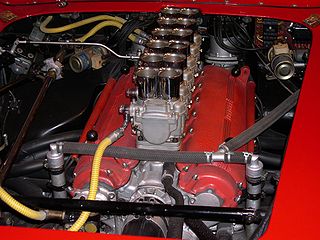
The Ferrari Colombo Engine was a petrol fueled, water cooled, carburetted 60° V12 engine designed by Gioacchino Colombo and produced in numerous iterations by Italian automaker Ferrari between 1947 and 1988. The maker's first homegrown engine, its linear successor is the Lampredi V12, which it far outlived, the last Lampredi being made in 1959.
Multijet is Fiat and General Motors joint venture in manufacturer since 1996 common rail direct injection turbo diesel diesel engine technology. Most of the Fiat S.p.A., Fiat Professional, Groupe PSA, Alfa Romeo, Maserati, Lancia, Chrysler, Chevrolet, Daewoo Motors, Cadillac, Karsan, Temsa, Iveco, Jeep, Opel, Vauxhall Motors, RAM Trucks, Mitsubishi Fuso, Maruti Suzuki, Suzuki, Tata Motors and Saab Automobile branded vehicles are equipped with Multijet engines. Ownership of some Fiat Multijet designs is shared with General Motors as part of a settlement of the failed merger between the two auto conglomerates. The GM Powertrain Torino group in Turin, Italy, manages its interest in these engines. Some PSA Peugeot Citroën diesel engines are also rebadged JTD units, and vice versa. Fiat's common-rail diesel engine is also known as JTD, an initialism of UniJet Turbo Diesel.

Alfa Romeo Giulia is the name of three not directly related models by the Italian car manufacturer Alfa Romeo. The first is a line of sporty four-door compact executive cars produced from 1962 to 1978, the second is an updated, mainly up-engined Spider, Sprint and Sprint Speciale Giuliettas, and the third Giulia is a compact executive car unveiled in 2015.

Solex is a brand name owned by a subsidiary of Italian automotive parts manufacturer, Magneti Marelli. The original Solex company was French-owned and produced carburetors and gasoline powered bicycles.
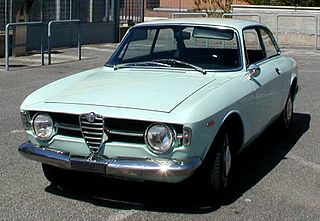
The Alfa Romeo 105 and 115 series coupés are a range of cars made by the Italian manufacturer Alfa Romeo from 1963 until 1977, based on a shortened floorpan from the Giulia saloon. They were the successors to the Giulietta Sprint coupé.

The Alfa Romeo Giulietta is a hatchback manufactured and marketed by Alfa Romeo, as a 5-door subcompact executive car. Production started near the end of 2009 and the model was introduced at the March 2010 Geneva Motor Show. The Giulietta placed second in the 2011 European Car of the Year awards. Between 2010 and 2019, production reached over 400,000. In 2020, Alfa Romeo announced that they were going to axe the Giulietta and production ended on 22 December 2020 spanning 10 years of sales from a period of 2010 to 2020. In total 469,067 examples were produced until 2020.

Designed by Aurelio Lampredi, the Fiat SOHC engine first appeared in the front-wheel drive (FWD) Fiat 128 of 1969. The in-line four-cylinder engine comprised an iron block with an aluminium cylinder-head containing a single overhead camshaft operating directly on both the inlet and exhaust valves in a reverse-flow cylinder-head configuration. The camshaft was driven by a belt rather than chain. The engine remained in production until about 2010 and grew in capacity over the years from 1100 cc to an eventual 1900 cc. The Fiat 130 2.9 L (2,866 cc) V6 engine, also appearing in 1969, although having crossflow cylinder head, is directly related to the 128 SOHC engine, but with a 1.20 upscale in bore and stroke. It was gradually replaced by the Pratola Serra engine series starting from 1995, although it was also converted to use a multivalve DOHC head, giving birth to the Torque engine, used until 2005.

Blue&Me is an integrated in-vehicle infotainment system used worldwide on many vehicles marketed by Fiat Chrysler Automobiles (FCA) from model years 2006–2017. With the exception of the Ford Ka, which is a lightly modified Fiat 500, the system is exclusive to Abarth, Alfa Romeo, Fiat and Lancia cars and to Fiat Professional's light commercial vehicles
The Quadrajet is a four barrel carburetor, made by the Rochester Products Division of General Motors. Its first application was the new-for-1965 Chevy 396ci engine. Its last application was on the 1990 Oldsmobile 307 V8 engine, which was last used in the Cadillac Brougham and full size station wagons made by Chevrolet, Pontiac, Oldsmobile, and Buick.

The Alfa Romeo V6 engine is a 60° V6 engine made by Alfa Romeo from 1979 to 2005. It was developed in the early 1970s by Giuseppe Busso, and first used on the Alfa 6 with a displacement of 2.5 L (2,492 cc) and a SOHC 12-valve cylinder head. Later versions ranged from 1,996 to 3,179 cc and had DOHC 24-valve valvetrains. The original design had short pushrods for the exhaust valves in a design similar to earlier Lancia Fulvia engines. The first DOHC version was in the 1993 Alfa Romeo 164, with an aluminium alloy engine block and head with sodium filled exhaust valves.

The Fiat 2300 is a six-cylinder executive car which was produced by Italian automotive manufacturer Fiat between 1961 and 1968. The 2300 was made as saloon, estate car and coupé. The 2300 saloon is noteworthy as in 1966 it became the first Fiat model to be available with an automatic transmission.

Selespeed is the name of an automated manual transmission used in Alfa Romeo cars, developed by Italian company Magneti Marelli and made by Graziano Trasmissioni.
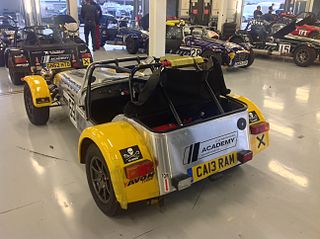
The Caterham Academy is a motor-racing championship exclusively open to novices, as their first foray into motorsport.
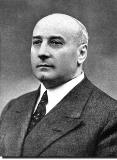
Edoardo Weber was an Italian engineer and businessman, famous for creating Weber Carburetors.

The Alfa Romeo Giulia is a compact executive car produced by the Italian manufacturer Alfa Romeo. Known internally as the Type 952, it was unveiled in June 2015, with market launch scheduled for February 2016, and it is the first saloon offered by Alfa Romeo after the production of the 159 ended in 2011. The Giulia is also the first mass-market Alfa Romeo vehicle in over two decades to use a longitudinal rear-wheel drive platform, since the 75 which was discontinued in 1992. The Giulia was second in 2017 European Car of the Year voting and was named Motor Trend Car of the Year for 2018. In 2018, Giulia was awarded the Compasso d'Oro industrial design award.
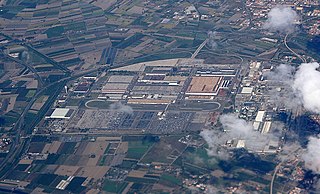
The Alfa Romeo Pomigliano d'Arco plant, commonly called simply Stellantis Pomigliano, is an automotive assembly plant now owned by Stellantis, officially known as the Giambattista Vico Plant since 2008, in memory of the Neapolitan philosopher. The plant, originally designed and constructed in 1968 by Alfa Romeo, is located largely in the town of Pomigliano d'Arco, and partially in the town of Acerra, employing roughly 6,000.

The Dino 206 GT, 246 GT and 246 GTS are V6 mid-engined sports cars produced by Ferrari and sold under the Dino marque between 1967 and 1974.